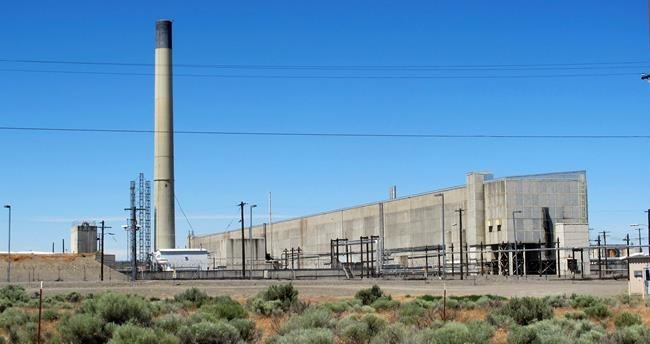Nicholas K. Geranios

FILE - This May 13, 2017, file photo, shows a portion of the Plutonium Finishing Plant on the Hanford Nuclear Reservation near Richland, Wash. Work to demolish the former nuclear weapons production factory in Washington state may resume in September 2018, about six months after it was halted when workers were exposed to radioactive particles, the U.S. Department of Energy said Thursday, July 26. The agency will implement extra safety measures for workers demolishing the Plutonium Finishing Plant. The plant was involved in producing much of the plutonium for the nation's nuclear arsenal. (AP Photo/Nicholas K. Geranios, File)
Republished July 26, 2018 - 4:30 PM
Original Publication Date July 26, 2018 - 3:06 PM
SPOKANE, Wash. - Work to demolish a former nuclear weapons production factory in Washington state may resume in September, about six months after it was halted when workers were exposed to radioactive particles, the U.S. Department of Energy said Thursday.
The agency will implement extra safety measures for workers demolishing the Plutonium Finishing Plant on the Hanford Nuclear Reservation, which is near Richland. The plant was involved in producing much of the plutonium for the nation's nuclear arsenal.
Hanford officials issued a report in late March that said a total of 42 Hanford workers inhaled or ingested radioactive particles when they were exposed during contamination events in June and December of last year. Radioactive contamination was also found outside plant offices and inside two dozen vehicles, the report said.
Demolition work was halted. Experts studied the dangerous work, looking for ways to make it safer for employees and the environment.
"Right now we are planning for a September resumption on demolition," said Karen Wiemelt, a manager at CH2M Hill Plateau Remediation Company, the private contractor performing the work for the Energy Department. She predicted demolition could be completed by next June.
Experts have identified techniques to make the work safer, including better and more frequent monitoring for radioactive contamination, better ventilation, minimizing waste piles and making sure that materials known as fixatives were used according to manufacturers' specifications, Wiemelt said.
Erecting a big containment tent over the plant site was rejected as too complicated and not worth the effort, she said.
"It would take us literally a couple of years to design and procure and build a tent," she said. "It makes far more sense to proceed very deliberately with enhanced controls."
Hanford is the nation's most polluted nuclear weapons production complex, and the complicated cleanup costs the federal treasury around $2 billion a year. The cleanup is expected to last for decades, and it involves buildings, 177 underground nuclear waste storage tanks and other facilities on a site that is half the size of Rhode Island.
The March report concluded that Hanford officials placed too much reliance on air-monitoring systems that failed to pick up the spread of radioactive particles. Managers of the private contractor were also caught between maintaining safety and trying to make progress toward project deadlines, according to the report.
Risk escalated as walls of the plutonium plant were knocked down and the rubble was stored in piles. Fixatives sprayed on the rubble to keep radioactive particles from blowing away may not have been effective, the report said.
The amount of radiation involved in the contamination incidents was low — even lower than naturally occurring levels of radiation people are exposed to in everyday life, the report said. But the project was not supposed to expose workers to any additional radiation. The amounts of radiation that have escaped are considered too small by state experts to pose a health risk. All the contamination was found on lands that are closed to the public.
Hanford was created during the Manhattan Project in World War II and made the plutonium for the atomic bomb dropped on Nagasaki, Japan, that effectively ended the war. The Plutonium Finishing Plant was constructed a few years later. The plant took liquid plutonium and shaped it into hockey puck-sized disks for use in nuclear warheads.
Demolition on the plant began in late 2016.
News from © The Associated Press, 2018